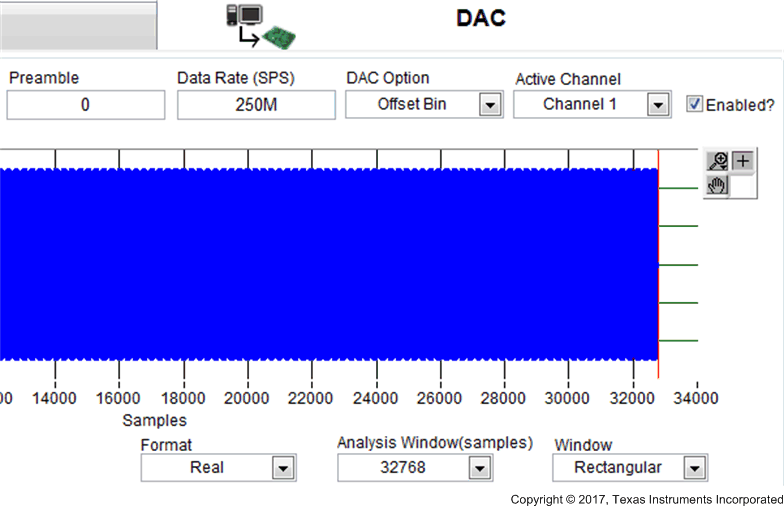SLWU087E november 2013 – june 2023
- 1
- High Speed Data Converter Pro GUI
- Trademarks
- 1 Introduction
- 2 Software Start up
-
3 User Interface
- 3.1
Toolbar
- 3.1.1 File Options
- 3.1.2 Instrument Options
- 3.1.3 Data Capture Option
- 3.1.4
Test Options
- 3.1.4.1 Notch Frequency Bins
- 3.1.4.2 2 Channel Display and Cursor Lock
- 3.1.4.3 Analysis Window Markers
- 3.1.4.4 X-Scale in Time
- 3.1.4.5 Y-Scale in Voltage
- 3.1.4.6 Other Frequency Options
- 3.1.4.7 NSD Marker
- 3.1.4.8 Phase Plot
- 3.1.4.9 Phase in Degree
- 3.1.4.10 Histogram
- 3.1.4.11 Disable User Popups
- 3.1.4.12 HSDC Pro Lite Version
- 3.1.5 Help
- 3.2 Status Windows
- 3.3 Mode Selection
- 3.4 Device Selection
- 3.5 Skip Configuration
- 3.6 Capture Button (ADC Mode Only)
- 3.7 Test Selection (ADC Mode only)
- 3.8 DAC Display Panel (DAC Mode only)
- 3.9 I/Q Multi-Tone Generator
- 3.1
Toolbar
- 4 ADC Data Capture Software Operation
- 5 TSW1400 Pattern Generator Operation
- 6 TSW14J58 Functional Description
- 7 TSW14J57 Functional Description
- 8 TSW14J56 Functional Description
- 9 TSW14J50 Functional Description
- 10TSW14J10 Functional Description
- A Signal Processing in High Speed Data Converter Pro
- B History Notes
- C Revision History
3.8.3 Parameter Controls
The five parameters used with the data file to generate the Time and Frequency domain plots are:
Scaling Factor (1x) – Scales the data based on the value (default is 1). This is applied for data loaded from files, and for the tone generated data. The scale data is sent to the DAC.
Preamble – The number of samples before the loop starting point (default is 0). This value must be in increments of 32.
Data Rate – Sample rate of I/Q samples of the test file. This is only used by the GUI FFT frequency display graph. The number is entered in Hertz (Hz), although the letter M may be appended to represent the sampling rate in MHz.
DAC Option – Determines if the test pattern file is either 2's compliment or Offset Binary.
Active Channel – Selects the channel in the test pattern file that is displayed (1, 2, 3, or 4) when the Enabled box is selected.
After a file has been loaded and the parameters updated, the GUI panel presents a graphical representation of the data. An example of an Offset Binary, 25.1-MHz tone with a data rate of 250 MHz is shown in Figure 3-39.
 Figure 3-39 DAC Test Pattern Display
Figure 3-39 DAC Test Pattern DisplayThe “Send” button will now become active. Clicking on this button starts the transfer of data from the TSW14xxx to a DAC EVM under test. This pattern is a looping test pattern that constantly runs until the send button is clicked on again.
On the TSW1400 EVM, every time the pattern starts over, a sync pulse will be generated on the SMA labeled "SYNC4". This active high pulse width will be 8 sample clock cycles wide. The SMA labeled "SYNC3" will have a clock that is the sample rate divided by 16. These signals can be used to trigger external test equipment such as a spectrum analyzer.
 Figure 3-40 Display Mode Options
Figure 3-40 Display Mode OptionsIn the middle of the display, there are three windows that allow the user to set the display mode of the test pattern to be sent, as shown in Figure 3-40. The data can be displayed as complex or real, the number of data points to display (from 1024 up to 524,288 depending on the TSW14xxx under test) and different windowing options.